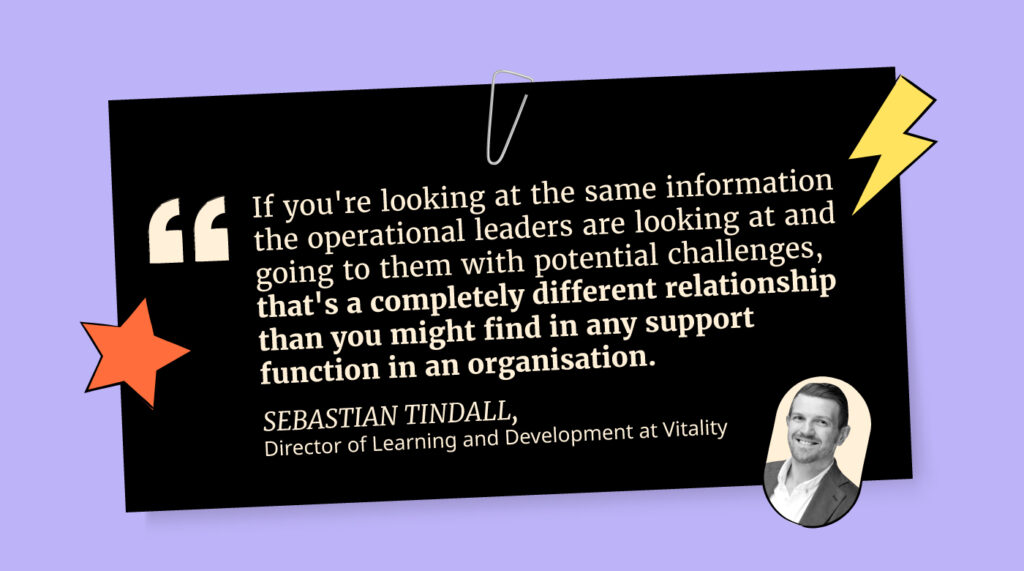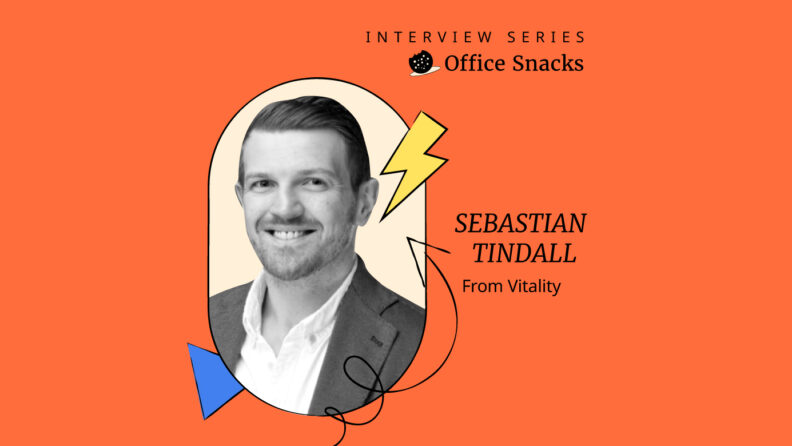In our Office Snacks series we interview members of our community to delve into their varied buffets of experience and come away with juicy insights and ideas.
Hi Sebastian, welcome to the series! We’d love to get to know you better, where are you based?
I’m based in Stockport, UK. It rains a lot but I was born here so I'm used to it.
How did you get to where you are today?
Not long out of university, I landed a graduate scheme with Santander where I used to get parachuted into different parts of the business that were underperforming.
I’d get put anywhere in the country where a contact centre wasn't doing so well and was given three to four months to work with the people and turn it around.
I absolutely loved it! If you got it right and worked with the people you could completely transform someone's performance. I started to get some real success with it and turned around some big contact centres.
I learned that it wasn't about coming in and being like a bull in a china shop. You have to help people through the process and understand that, although you probably weren't welcome in the first place, you really had to win people over from a credibility perspective and know what you were doing.
Eventually, I realised that could be a full-time job and, actually, that's what I want to do—I want to help other people do their job and help them succeed.
How do you describe what you do to others?
It depends who it is. If it's one of my friends, every time I explain my job it's a bit like Chandler Bing in Friends. Nobody has an idea of what I actually mean—I think it must be the way I explain it!
But, when it's internally, it's equipping people to be able to perform their job to the best of their possible ability.
I think that’s the easiest way.
How do you approach learning and development at Vitality?
We're very performance-focused as a team.
When people come to us saying we need some training on X, which is a knowledge-based activity, we'll say, “Well, yeah, but what do you actually need to do?”.
We take time to unpick the issue and make it clear we're not here to just enable people to know everything, because it's completely false endeavour and it's a pointless one. We act like a commercial entity so we need to focus specifically on tasks.
For example, we’d ask something like “What do you actually need to be able to do in your first 30 days to be proficient in that job?” And then that’s the focus. We can lay other things on afterward.
I think this approach has really helped conversations in the organisation because it helps people understand that there is a quantifiable purpose to having an L&D department which is performance enablement, not just knowledge-based (which is very limited).
What are your favourite tools that help you with your job?
So the people we’re helping’s main diet of work is really technically focused. There's an ever-evolving body of products being launched, so we're focused on being there to help people service them.
There are a number of tools we use, for example nudge-based technology that’s incorporated into our login systems e.g. when someone comes in it will test them on key processes and we can scrape that information.
There's also a lot of rapid digital content that we try and embed into people's roles. Again, that's task-based, but we also use digital adoption technology as well so we can see how long it takes someone to process a particular task.
From there we can see what’s taking the longest so we know what to focus on and how we can better support people.
What’s your favourite part of your job?
First off, I like being connected to the commercial part of the business. It's like, “This is how we make money, we understand that, this is how we’re going to help enable that.”
But more than that it's enabling the purpose of the business. We are here to help our members live healthier and happier lives, so how does what is Im doing enable that?
And the second part is that we generally draw people from frontline roles and give them their first L&D job.
Over 80% of the team comes from frontline roles and we train them up, pay for their qualifications, and help them develop.
That's the stuff that really keeps me motivated. It's making people's careers in L&D, seeing them grow, and seeing them kind of find their vocation for the future. That’s without doubt the most rewarding.
What would you say is the most challenging aspect?
The pace and the volume of change. If you delivered L&D by the textbook it would never work here because there isn’t time and it would restrict innovation.
When you've got somebody trying to launch something that's market-leading, you can't sit there and say “Great, it’ll take two months to train these people out because you know, we've got 3 classrooms etc.”
We’ve had to completely change the way we operate, which is quite atypical.
For example, you come to us with a change. Rather than roll out 50 hours of training, we'll benchmark and test people and see which parts of that change are intuitive because, if it's intuitive and people get it straight away, you don't need to train anyone, you just need to point them towards the resources that are there.
So we test there, and, if it’s intuitive, off it goes. If it isn't, then it immediately raises the question of why we're rolling it out and that’s a different conversation.
So, if you're rolling out a new product, you'll test your people on how okay they’re with it naturally. If they do require some training on it, what’s the next step?
When we test for intuitiveness we identify the areas that people will struggle with. That feedback goes to process owners, and then we'll work with them to say, “Well, do you wanna change that or not? ”
Through the process, we also identify the most critical things that people have to get right, and then they're the focus for the resources we will place in the most convenient places possible
That means that, when someone contacts us, the key information is easy to access and the learning experience can continue as people develop in the role.
There's far less cognitive load on people because, you know, there's actually such a small amount of information that you can administer in any single dose. Our approach is to empower them to develop on an ongoing basis.
That's the difference, to get people by so they can learn “in the flow” and teach themselves over an extended period of time, which has allowed us to reduce speed to competency by over 30%.
It's a process that works, but it takes a lot of time to explain in organisations because they sit there and say, “Well, you're not training people on everything,” and we say “Nor should we be”.
Overall, we're targeting ourselves on training people less, but equipping them to do their jobs better. It's a bit of a tough one to rationalise, but that is both the hardest and the best bit about the job here.
What’s been your most successful initiative to date and why?
I think the best thing has been reimagining our induction process. It sounds really commodity-based and simple, but we're working in an organisation where there are some really nuanced products.
Quite often when people contact us, particularly when they're making a claim, they’re in a moment of need. They're possibly not well or they need medical support, so it’s how do you make your organisation quick enough so that, when there are staff-level fluctuations and growth, you can still get your people ready in the required time to be able to deal with the ever-evolving myriad of contacts that you might receive as a business.
We have forensically looked at data points like speech data, what topics are mentioned in calls, the common issues that people talk about when they contact us, the secondary mentions to capture the typical “Whilst I've got you on the phone” type queries.
The critical task, then, is to cater to enough of that demand to help our members without overloading new staff—we have done this mathematically and I have loved informing that balance. How does taking X out impact our member sentiment vs the impact on speed?
You're trying to reduce cost and speed, but you can't really compromise on quality. The great news is that we have done that, we have reduced initial instruction by over 25%, reduced speed to competence by 30%, and new staff have never performed better.

What would you say is the biggest misconception about L&D?
I imagine many people feel the same way about their job, but whenever anyone comes to L&D asking for something and they think they already know the answer.
People will come to you and say they think they need some classroom training on X, which is strange because I would never dream of telling someone how to do their job. You talk through the problem first and then the solution comes a distant second.
I'll always start that again by talking about being a solution agnostic. If the answer's training, brilliant, but, if training isn’t the answer, then we're not gonna sit here and train people for the sake of training them.
Let's do an analysis together, and, if we are part of the solution, fantastic. But it's such a strong data focus in the early stages. People will come to you with a kind of conjecture or sentiment or feeling, and it's not to be completely discounted, but the business case prevails.
You’re collecting lots of data from all different kinds of places. Where do you collect it from?
There're a lot of places. Using the same information that our operational leaders pore over is something we take great pride in because there's nothing worse then when you come to a team and they don't understand your challenges.
By the time someone's coming to you with a problem and presented it, if you don't understand it, you’re kind of on the back foot already. It could even be too late.
If you're looking at the same information the operational leaders are looking at and going to them with potential challenges, that's a completely different relationship than you might find in any support function in an organisation.
You can’t be presented with the analysis after it has happened, you have to be in the room when the analysis is happening. You need to be there when problems are discussed, not when the conclusions have already been drawn.
If a company is just starting out with L&D function, what is your number one piece of advice?
Start collecting data. Find out what data’s the most prevalent and the most used in your organisation and then start to understand it.
If you can understand the links between the data, the conversations that the data sparks, then you’ll be far better equipped when you do get into those meeting rooms—you'll be speaking their language and that is the number one thing that's going to ingratiate you.
There's nothing worse than L&D departments going “We've cooked up this new programme for you and it's on coaching and you'll love it and it'll really help you,” and it's not anything to do with the problems being facing right now.
That way, they’re not going to see your value. They will see you as an isolated support function and not part of their team
Last, and most importantly, what’s your favorite office (home or otherwise) snack?
Snyders Buffalo Pretzel Pieces. They're like toasted pretzel pieces that have been soaked in Buffalo sauce. They are nothing short of life-changing—I would just like to disclose that I get no financial incentive from promoting this snack so passionately!
What’s your favorite office snack?
Work in People and Culture? Want to share your ideas?
Applications to be interviewed are open to anyone (yes anyone!) so don’t hesitate to fill in the form for an opportunity to share your knowledge and ideas.




